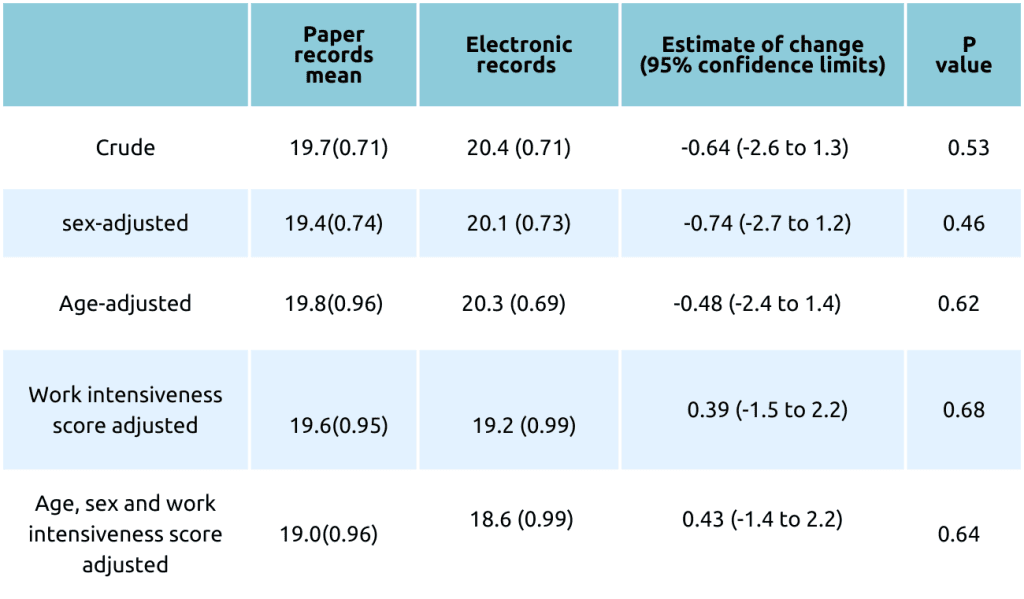How Digital Adoption Changed Life – Before & After at Sankara Nethralaya
Read the Magazine in PDF
EMR systems serve as a fundamental tool for managing patient data securely and efficiently in the healthcare industry, which is becoming more data-driven with the rising amount and speed of data generated.
By - Dr R R Sudhir
Abstract
This article discusses the impact of digital adoption on healthcare, particularly the use of Electronic Medical Records (EMR) systems. The benefits of EMR systems, such as quick access to patient records, improved transparency, and increased patient engagement. It also discusses the cost-effectiveness of EMR systems and the potential savings in lives they offer. Exploring various techniques and technologies used to reduce waiting times, including the use of drawings, medical images, and powerful search engines. Overall, the article emphasizes the critical role of digital adoption in healthcare and the benefits it provides to patients and healthcare providers.
Introduction
The healthcare sector is continuously evolving, and as a result, there is a growing need for efficient and dependable data management systems. Electronic Medical Records (EMR) have become a top priority for the healthcare industry. They are designed to store and manage large amounts of patient data, which include demographic details, medical history, lab results, and diagnostic images. This information is crucial for delivering high-quality patient care, conducting research, and ensuring compliance with regulations.
One significant advantage of EMR systems is their ability to handle vast amounts of data that are generated at a rapid pace. This data is generated by numerous sources such as medical devices, diagnostic procedures, and multiple other units that need to be captured and organized. The collected data is then utilized for various purposes, including auditing, quality control, identifying patients for research, and measuring the quality of patient care.
EMR systems are not just a component of a hospital but an integral part of the healthcare ecosystem. The system connects various departments of the hospital, ensuring continuity of care for patients. The system also integrates with other hospitals, both in India and overseas, to ensure that patients receive the best possible care. EMR systems provide support for artificial intelligence and establish standards for data management, making them a critical component of the healthcare industry. The cost of implementing an EMR system in the healthcare industry may be high initially, but the benefits outweigh the investment. Automating manual systems using EMR reduces the risk of errors and streamlines data management, enabling healthcare providers to access patient data efficiently and enhance the quality of care.
“EMR systems serve as a fundamental tool for managing patient data securely and efficiently in the healthcare industry, which is becoming more data-driven with the rising amount and speed of data generated”.
Therefore, EMR systems are crucial for ensuring quality patient care and optimizing the overall performance of the healthcare ecosystem.
The Rising Costs of Electronic Medical Records and Their Benefits
The use of electronic medical records (EMRs) has been a subject of debate in the healthcare industry due to the associated fees, raising concerns about their cost-effectiveness.
However, recent research indicates that if the fees charged for EMRs are fully utilized, they have the potential to save up to 69 lives. EMRs offer several advantages, such as quick and easy access to patient records, unlike traditional paper records which can take a long time to find. This not only saves time but also improves the quality of patient care. Patients have reported a reduction in waiting time for treatment with the use of EMRs. In addition, EMRs increase transparency, allowing patients to actively participate in their care. Patients can monitor the progress of their treatment and understand what they need to do to improve their health, which leads to increased patient satisfaction and engagement in their care. The study also found that the time taken to access EMRs is not significantly different from accessing traditional paper records. This suggests that the use of EMRs does not impede the process of accessing patient records.

EMRs are a valuable tool for doctors and healthcare providers as they offer several benefits. One of the most significant benefits is the ability to predict patient outcomes by analyzing data in the records. By doing so, doctors can plan treatments accordingly and avoid ineffective treatments, freeing up time for those that are more likely to be successful. EMRs also allow for the use of abbreviations and shortcuts, making it quick and easy to enter information into the records. This not only saves time but also reduces the risk of errors and ensures that the information entered is accurate. Furthermore, EMRs help improves the continuity of care for patients by giving doctors access to all of their records. This allows for better-informed decisions about their care and can help reduce the risk of mistakes. EMRs also increase transparency and patient engagement in their care by allowing patients to see the progress of their treatment. While the fees for EMRs may seem high, the benefits they offer make them a worthwhile investment for healthcare providers.
Improved access to patient records, the ability to predict patient outcomes, the use of abbreviations, and improved continuity of care all contribute to saving time, improving the quality of care, and reducing the risk of mistakes.
Reducing Waiting Times in Healthcare
To improve the patient experience, healthcare facilities have implemented various techniques and technologies aimed at reducing waiting times. One such technique involves the use of drawings and images to quickly identify and diagnose a patient’s condition. With the latest technologies, even the use of drawings can be reduced as medical images of the patient can be taken and analyzed. Healthcare providers have also introduced a powerful search engine to quickly search and retrieve relevant templates and information, reducing the time required to diagnose and treat patients.
These techniques have been shown to significantly reduce waiting times. Electronic Medical Records (EMR) have made it easier to quickly generate medical prescriptions and cases with just one click of a button. Patients can access their medical information from a secure patient portal via email, along with all relevant attachments, including diagnostic modalities. Integration with stores and equipment has also helped to reduce waiting times. For example, pre-ordering equipment such as eyewear helps reduce the supply chain and ensures that patients have what they need when they need it. Additionally, the integration of investigation reports with healthcare facilities reduces the need for patients to travel to different clinics for investigation and can be done via teleconsultation. This saves time and reduces the burden on patients.
The healthcare industry has implemented several techniques and technologies to reduce waiting times and improve the overall patient experience. One method is the use of digital cameras and continuous patient recording, which enables surgeons to complete AP notes and maintain a continuous record of the patient. This helps with consultations and reduces the time patients spend in healthcare facilities upon discharge. By implementing various technologies such as EMR, the use of drawings and images, and integration with stores and equipment, the healthcare industry has made significant progress in reducing waiting times. These efforts have improved the patient experience, reduced the burden on patients, and made it easier for healthcare providers to diagnose and treat patients.
As the industry continues to search for ways to enhance patient care, technology plays a crucial role. Data mining is one of the innovative solutions that have emerged and has been a game-changer in the industry. During the COVID-19 pandemic, telemedicine became popular, and healthcare providers developed consultation platforms for patients, providing an opportunity to utilize technology to its fullest potential.
American Medical Association (AMA) platform
The AMA platform was created to enable patients to perform self-assessments, vision assessments, and upload pictures and old reports using their mobile devices. Patients could connect with their doctors via audio and video calls on Google Meet, and the platform guided patients through the process of taking their medical histories, completing questionnaires, and uploading reports. The platform has facilitated daily consultations, with leads coming from various sources, including partnerships with optical chains. Patients could visit the optical chains to get a complete follow-up, as they were equipped with cameras that took images that were later analyzed by healthcare providers.
The platform’s key feature is its ability to provide quality feedback, which is easily accessible via feedback forms, and healthcare providers have a dashboard for analyzing all the feedback received.
The healthcare platform, AMA, not only facilitates patient care but also allows for research and data analysis. The EMR system, with criteria built-in, provides structured data that can be easily mined using data mining tools. The analytics can be viewed through an interactive dashboard that displays a comprehensive picture of the patient’s progress and engagement, such as the Outcome Analysis of Refractive Surgery. The platform is highly automated, flexible, and can handle large amounts of data with over 40,000 visits recorded. The use of data mining in the healthcare industry has been revolutionary, and telemedicine has become a crucial aspect of patient care. The AMA platform is a prime example of how technology is improving healthcare services, and its impact on the industry is set to increase in the future.
Cataract Surgery Outcomes: The Importance of Quality
High-quality cataract surgery is crucial for positive patient outcomes. A computer-based training program was introduced in 2005 to improve quality, resulting in 15,000 users and 25,000 appointments across major and smaller cities. The program follows strict guidelines and standards and can be replicated in other institutions. Electronic medical records (EMR) have made medical records accessible from anywhere, improving convenience and accessibility for patients. The importance of high-quality cataract surgery cannot be overstated, and technology advancements have made it easier to ensure patients receive the best care possible.
Conclusion
In conclusion, the adoption of digital technology has transformed the healthcare industry in numerous ways. Electronic Medical Records (EMRs) have become an integral part of the healthcare ecosystem, connecting various departments of hospitals, integrating with other hospitals both locally and globally, and providing support for artificial intelligence. Despite concerns about the costs of implementing EMRs, recent research has shown that they have the potential to save lives and offer several benefits, including quick and easy access to patient records, improved patient engagement, and increased transparency. Additionally, the use of drawings and images and powerful search engines has reduced waiting times and improved the patient experience. Overall, digital adoption has significantly enhanced the quality of patient care and optimized the performance of the healthcare ecosystem.
Author
-

Head, Department of Preventative Ophthalmology, Sr Consultant, Cornea and Refractive Surgery, Sankara Nethraalaya, Chennai



